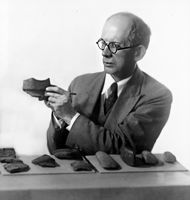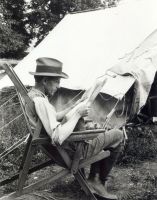|
Waterloo Region Generations
A record of the people of Waterloo Region, Ontario. |
William John Wintemberg
-
Name William John Wintemberg Born 18 May 1876 New Dundee, Wilmot Twp., Waterloo Region, Ontario, Canada  [1, 2, 3]
[1, 2, 3] Gender Male Residence 1891 Wilmot Twp., Waterloo Region, Ontario, Canada  [2]
[2] Lutheran Died 25 Apr 1941 Ottawa, Carleton Co., Ontario, Canada  [3]
[3] Hall of Fame - Waterloo Region Bef 2012 , Waterloo Region, Ontario, Canada  [4]
[4] Eby ID Number Waterloo-123074 Buried Beechwood Cemetery, Ottawa, Carleton Co., Ontario  [3]
[3] Person ID I123074 Generations Last Modified 10 Jul 2025
Father Francois Xavier "Frank" Wintemberg, b. 1845, , Ontario, Canada  , d. 19 Jun 1921, Kitchener, Waterloo Region, Ontario, Canada
, d. 19 Jun 1921, Kitchener, Waterloo Region, Ontario, Canada  (Age 76 years)
(Age 76 years) Mother Elizabeth Lederman, b. Sep 1849, Wilmot Twp., Waterloo Region, Ontario, Canada  , d. 9 Apr 1917, St. Thomas, Elgin Co., Ontario, Canada
, d. 9 Apr 1917, St. Thomas, Elgin Co., Ontario, Canada  (Age ~ 67 years)
(Age ~ 67 years) Family ID F30608 Group Sheet | Family Chart
-
Photos 
William John Wintemberg 
Wintemberg,WilliamJohn-0002.jpg
William J. Wintemberg conducted the first extensive excavations of the Lawson site over the summers of 1921, 1922 and 1923.
-
Notes - WILLIAM JOHN WINTEMBERG
1876-1941
Lack of education does not keep a man from reaching great heights. William Wintemberg, a blacksmith's son, born in New Dundee of German-Alsatian parents, overcame several handicaps, and was elected to fellowship in the Royal Society of Canada.
A shy, retiring boy, weak physically, he was apprenticed to a tailor. At sixteen he worked in Toronto as a printer, and later a coppersmith. He became a helper at the Ontario Provincial Museum, and due to his great interest in Indian artifacts was appointed assistant to the chief archaeologist of the Royal Victoria Museum, Ottawa. In 1926, for health reasons, he curtailed his work but continued to take part in excavations throughout Ontario, Quebec and the Maritimes. He worked at the St. Ignace II research project.
An expert in Iroquoian archaeology, he published seventy-five articles and pamphlets. His book, Folklore of Waterloo County , gives a true picture of the early settlers.
Waterloo Region Hall of Fame
____________________
William John Wintemberg was born at New Dundee, Ontario, on May 18, 1876. Even in childhood he was extremely delicate, and more than once the family doctor pronounced that his weak heart would never carry him to manhood. As soon as he was old enough to leave school his father apprenticed him to a tailor, but the boy was so unhappy that be packed up his books and ran away to Toronto, where a printing firm engaged him as a compositor. After handling lead type for a few years he developed lead-poisoning, and gave up this work for the only other employment he could find, brass and copper-smithing. Neither occupation was very remunerative; in 1911, when he was accounted a skilled coppersmith, his salary for a ten-hour day was only $12 a week.
Always debarred from any strenuous pursuit by his weak heart, Wintemberg was from boyhood an ardent student who could never pass a second-hand bookstore without brooding over some of its musty volumes and counting the dimes in his pocket. He collected butterflies and other natural history specimens, burrowed into the early history of his own and neighbouring counties, listed place-names and their origins, picked up old Indian implements and mapped the positions of ancient Indian village sites and burial places. With the help of a friend he organized a society in Toronto for the study of folklore. These antiquarian activities brought him into contact with the Director of the Ontario Provincial Museum, Dr. David Boyle, who sought his help in arranging and labelling the museum's specimens, then exhibited in the Normal School, and later tried to attach him to the museum staff. Though the provincial government of that day did not fully appreciate Boyle's needs and supplied him instead with a good party member who could not distinguish an arrowhead from an axe, Wintemberg maintained a close connection with the Provincial Museum until 1911 and published many valuable papers on Ontario archaeology in its series of Annual Reports. In that year he attached himself to the Victoria Memorial Museum (later the National Museum of Canada), in Ottawa, first as a part-time field-worker, then from 1912 as a full-time preparator on its staff. This association marked a happy turning-point in his life; it released him from the manual labour for which he was physically unfit and enabled him to devote all his energies to the things that lay nearest his heart, the archaeology of eastern Canada, and Ontario place-names. In 1925 the department in charge of the National Museum promoted him to Assistant Archaeologist and in 1937 to Associate Archaeologist, a position he held until his death on April 25, 1941.
One of his first major achievements was the excavation, in 1912 and 1915, of the old Indian village at Roebuck, forty miles south of Ottawa. His careful description and analysis of the Roebuck remains have been a basis for all later investigations into Ontario archaeology. After this came studies of other Ontario sites, and brief outlines of his discoveries in Quebec and the Maritimes, until in 1929 he was ready to publish his "Distinguishing Characteristics of Algonkian and Iroquoian Cultures," which has been an unfailing reference work for amateur and professional archaeologists alike. Despite his poor health, and the knowledge that his life might be cut short at any moment without warning, he twice explored the north shore of the Gulf of St. Lawrence and in 1929 travelled up the northwest coast of Newfoundland. There too his investigations bore fruit. They extended the range of the Iroquois along the north shore of the gulf as far east as Kegaska; and they revealed, rather surprisingly, that Eskimo, not Indians, had occupied the whole north coast of Newfoundland before the coming of the white man, and that these Eskimo were an offshoot of the mysterious 'Dorset' people who have left numerous remains in the Hudson Bay region, but none at all in the western Arctic. On one of his last field-trips he located and partly excavated, near Waubaushene, Ontario, the site of the old Jesuit mission of St. Ignace II where Fathers Breboeuf and Lalement were massacred in 1649 by the Iroquois.
Besides his early contributions to the Annual Reports of the Ontario Provincial Museum, and his reports in the National Museum of Canada series, Wintemberg published a large number of papers, some of them in the Transactions of the Royal Society of Canada, which showed its appreciation of his work long before it elected him Fellow in 1934. His papers cover a variety of topics, among them place-names, though the immense mass of notes he collected on that subject still awaits an editor. He also gathered much material on the history of lighting in preelectricity days, which he hoped to incorporate into a treatise and illustrate from his private collection of old lamps and candlesticks, one of the best on the continent.
Wintemberg's home in Ottawa was an artistic delight. It was built according to his own plans, with door-knockers and other wrought-iron ornaments of his own making. Much of its furniture he made himself, for he was a skilful and sensitive craftsman. It is amazing that a man who was always conscious of walking on the brink of the grave should have possessed the high faith to attempt so many things, and the tenacity to succeed in everything he undertook. Success, however, was a word that he rarely used. Without question he was the leading authority on Canadian archaeology, and his advice was sought by scholars everywhere; but he remained always the simple and modest student, eager to learn and to help others in their quest for knowledge. His life's motto was work, work not for material things, for he never valued money or the ordinary things that money will buy, but work to extend rnan's knowledge and to reveal something of the beauty and truth of life. The afternoon before his death he was admiring the dandelions on his lawn; and after he re-entered his house and was browsing through his papers he slipped this quotation from Leonardo da Vinci into a book he had been reading:
"Life well spent is long. Thou, O God, dost sell unto us all good things at the price of labor. A well-spent day brings happy sleep, so life well used brings happy death. I thought I was learning how to live. I have been learning how to die."
American Antiquity Vol.7(10):64-66, 1941.
- WILLIAM JOHN WINTEMBERG
-
Sources - [S140] Census - ON, Waterloo, Wilmot - 1881, Div. 3 Page 35.
- [S939] Census - ON, Waterloo, Wilmot - 1891, Div. 1 Page 43.
- [S3231] Find A Grave, https://www.findagrave.com/memorial/204881525/william-john-wintemberg.
- [S220] Waterloo Region Hall of Fame Waterloo Region Hall of Fame.
- [S140] Census - ON, Waterloo, Wilmot - 1881, Div. 3 Page 35.
-
Event Map  = Link to Google Earth
= Link to Google Earth
This site powered by The Next Generation of Genealogy Sitebuilding ©, v. 12.0.1, written by Darrin Lythgoe 2001-2025.